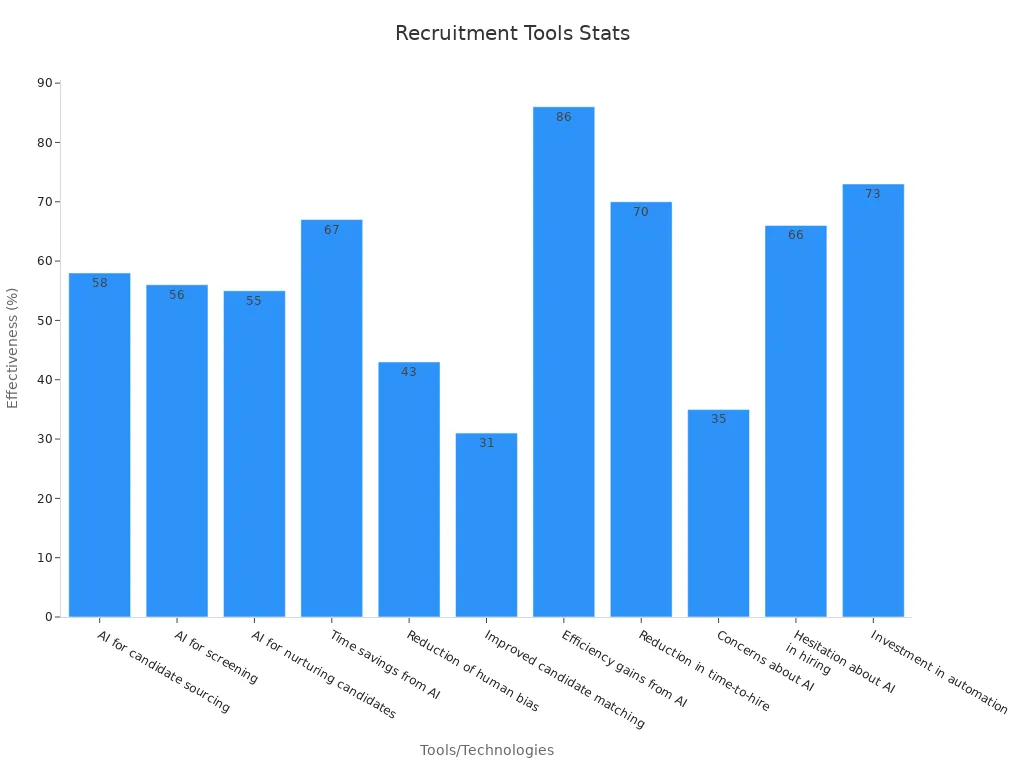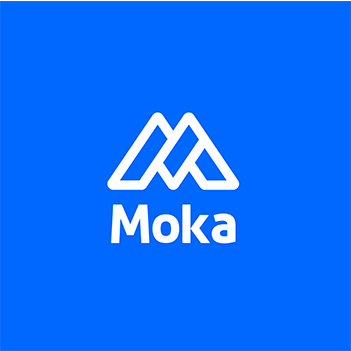How to Analyze Recruitment Funnel Metrics to Reduce Candidate Drop-Off

Recruitment Funnel Analytics: Where Are You Losing Candidates? play a critical role in understanding where candidates drop off during the hiring process. By identifying these points, you can address issues that may discourage applicants, such as lengthy applications or unclear job descriptions. A positive candidate experience is essential. Research shows that candidates with a good experience are 80% more likely to reapply, which improves job acceptance rates. Recruitment funnel analytics also help pinpoint bottlenecks, enabling you to streamline processes and reduce drop-offs. This leads to a smoother hiring journey and ensures you attract and retain top talent.
Key Takeaways
Find where candidates stop in your hiring process. Use numbers like how many finish applications to see where they lose interest.
Make applying easier by asking fewer questions and making it work on phones. A simple application keeps more people interested.
Make the process better with clear updates and quick replies. Sharing information builds trust and keeps candidates involved.
Use tools like AI to make hiring faster and smarter. Automation saves time and helps pick the best people.
Check your hiring numbers often to change plans if needed. Watching data helps you stay ahead and hire better.
Recruitment Funnel Analytics: Where Are You Losing Candidates?

Defining recruitment funnel metrics
Recruitment funnel metrics help you measure and evaluate the effectiveness of your hiring process. These metrics track candidate progress through each stage of the funnel, from awareness to hiring. For example, "Time to Fill" measures how long it takes to close a job opening, while "Candidate Conversion Rate" shows the percentage of applicants moving from one stage to the next.
Metric | Description | Industry Benchmark |
|---|---|---|
Time to Fill | Measures the total time taken to fill a job opening. | 30 to 45 days for tech roles; as low as 14 days for top performers. |
Candidate Conversion Rate | Percentage of applicants moving through hiring stages. | 30% from application to interview; 50% from interview to offer. |
Offer to Hire Ratio | Measures the percentage of offers accepted by candidates. | 55.6% |
By defining these metrics, you can identify areas needing improvement and set benchmarks to measure success.
Why tracking metrics is essential for reducing drop-offs
Tracking recruitment metrics allows you to pinpoint where candidates drop off. For instance, 92% of candidates who click "Apply" fail to complete the application. Additionally, up to 40% abandon applications that are not mobile-friendly. These numbers highlight the importance of monitoring each stage.
Without tracking, you might overlook critical bottlenecks. For example, 25% of candidates drop out during the interview stage. This suggests the need to evaluate interview processes for length, fairness, and consistency. Tracking metrics ensures you address these issues and improve the overall candidate experience.
Benefits of optimizing recruitment funnel performance
Optimizing your recruitment funnel improves hiring outcomes. Simplifying applications, making them mobile-friendly, and providing timely feedback can significantly reduce drop-offs. Structured interviews and clear communication also enhance the candidate experience.
Metric | Description |
|---|---|
Conversion Rates | Measure the percentage of candidates who complete the funnel. Low rates may indicate complexity. |
Drop-Off Points | Identify where candidates abandon the funnel, suggesting areas for simplification. |
Time Spent per Step | Analyze time spent on each part of the funnel to identify sections needing improvement. |
By focusing on these areas, you can attract top talent, reduce time-to-hire, and improve offer acceptance rates. Recruitment Funnel Analytics: Where Are You Losing Candidates? helps you achieve these goals by providing actionable insights.
Stages of the Recruitment Funnel and Common Drop-Off Points

Awareness: Challenges in reaching potential candidates
Reaching potential candidates is the first step in the recruitment funnel, but it often presents challenges. Many companies struggle to connect with the right audience, especially in niche markets or when brand awareness is low. Tailored outreach strategies can significantly improve engagement.
Evidence Description | Outcome |
|---|---|
Increased engagement with potential candidates | |
Recruitment from niche markets despite low market awareness | Enhanced brand visibility and candidate variety |
Improved candidate engagement through authentic storytelling | Better alignment with candidate motivations |
To overcome awareness challenges, focus on crafting personalized messages and sharing authentic stories about your company. These efforts expand your candidate pool and attract diverse talent.
Attraction: Issues with job postings and employer branding
Attracting candidates depends heavily on how you present your company and job opportunities. Poorly written job postings or a weak employer brand can deter top talent. Research shows that 76% of candidates want to understand team culture and values before accepting a job offer. Companies that invest in employer branding are three times more likely to make quality hires.
Statistic | Source |
|---|---|
Companies that invest in employer branding are three times more likely to make a quality hire. | |
76% of candidates want to know about team culture and values before accepting a job offer. | Harvard Business Review |
Companies with a strong employer brand can see a 50% decrease in cost per hire. |
To attract candidates effectively, highlight your company’s culture, values, and mission in job postings. A strong employer brand not only increases offer acceptance rates but also reduces hiring costs.
Application: Barriers to completing applications
The application stage often sees high drop-off rates. Complex or lengthy application forms discourage candidates from completing the process. Studies reveal that 92% of candidates who click "Apply" fail to finish their applications. Additionally, up to 40% abandon applications that are not mobile-friendly.
To address these barriers, simplify your application forms and ensure they are mobile-optimized. Accepting recent work examples instead of lengthy assessments can also reduce frustration. By making the process user-friendly, you can retain more candidates and improve conversion rates.
Screening: Misalignment in qualifications or expectations
Screening candidates is a critical step in the recruitment funnel, but it often reveals mismatches between qualifications and job requirements. This misalignment can lead to wasted time and resources. For example, recruiters spend an average of 23 hours screening resumes for a single hire, yet 75% to 88% of candidates are deemed unfit for the role.
Statistic | Value |
|---|---|
Percentage of recruiters finding screening challenging | 52% |
Average hours spent screening resumes for a single hire | 23 hours |
Percentage of candidates considered unfit | 75% to 88% |
To address this issue, you can refine job descriptions to clearly outline required skills and qualifications. Leveraging technology, such as applicant tracking systems (ATS), can also help filter resumes more effectively. By aligning expectations early, you reduce drop-offs and improve the quality of candidates moving forward.
Interviewing: Communication and scheduling challenges
The interview stage often experiences delays and miscommunication, which can frustrate candidates and lead to drop-offs. For every 100 candidates who complete the screening call, only 30 proceed to interviews. This low conversion rate highlights potential issues like slow scheduling or unclear communication.
When 100 candidates complete the screening call, only 30 proceed to interviews, resulting in a 30% conversion rate.
Delays in scheduling interviews can cause candidates to lose interest or accept other offers.
Improving the speed of feedback and communication enhances candidate engagement and reduces drop-off rates.
To overcome these challenges, streamline your scheduling process by using automated tools. Clear and timely communication about interview expectations also helps candidates feel valued and engaged.
Hiring: Delays in decision-making or offer acceptance
The final stage of the recruitment funnel is where you secure top talent, but delays in decision-making or offer acceptance can derail the process. Candidates often expect quick responses, and prolonged waiting periods may lead them to accept competing offers.
To minimize delays, establish a structured decision-making process with clear timelines. Communicate transparently with candidates about the status of their application. Offering competitive packages and addressing candidate concerns promptly can also improve offer acceptance rates. By acting swiftly, you ensure that the best candidates join your team.
Collecting and Analyzing Recruitment Funnel Data
Key metrics to track at each stage
Tracking the right metrics at every stage of your recruitment funnel helps you understand its performance and identify areas for improvement. Each stage has specific metrics that provide valuable insights:
Stage of Recruitment Funnel | |
|---|---|
Sourcing and Attraction | Time-to-Fill, Source of Hire, Cost-Per-Hire |
Candidate Engagement | Application Completion Rate, Candidate Drop-off Rate, Candidate Experience Survey Scores |
Evaluation and Selection | Screening Efficiency, Interview-to-Offer Ratio, Offer Acceptance Rate |
For example, tracking "Time-to-Fill" during sourcing shows how quickly you can attract candidates. Monitoring "Application Completion Rate" during engagement highlights whether your application process is user-friendly. These metrics allow you to pinpoint inefficiencies and make data-driven decisions.
Tools and technologies for data collection
Using the right tools simplifies data collection and analysis. Many companies now rely on AI-powered solutions to streamline recruitment processes.
Tool/Technology | Effectiveness Statistic |
|---|---|
AI for candidate sourcing | 58% of companies use AI for this task |
AI for screening | 56% of companies use AI for this task |
AI for nurturing candidates | 55% of companies use AI for this task |
Time savings from AI | 67% of companies report time savings |
Reduction of human bias | 43% of companies cite this benefit |
Efficiency gains from AI | 86% of recruiters report enhanced efficiency |
AI tools not only save time but also improve candidate matching and reduce human bias. Predictive analytics is another powerful tool that forecasts hiring needs and identifies effective strategies.

Identifying trends and bottlenecks in the funnel
Analyzing trends and bottlenecks ensures your recruitment funnel operates efficiently. Start by using quality data sources to track metrics like drop-off rates at each stage. Multi-touch attribution helps you determine which parts of the funnel convert the most candidates.
Metric | Description |
|---|---|
Time to Hire | Measures the duration from job opening to candidate acceptance, indicating recruitment efficiency. |
Cost per Hire | Total cost of hiring divided by the number of hires, ensuring cost-effectiveness in recruitment. |
Quality of Hire | Evaluates how well the recruitment process identifies quality talent and their alignment with goals. |
AI-powered solutions and predictive analytics also play a key role. They automate tasks, forecast hiring needs, and highlight effective recruitment strategies. By identifying bottlenecks, you can refine your funnel and improve overall performance.
Strategies to Reduce Candidate Drop-Off
Enhancing the candidate experience
A positive candidate experience plays a crucial role in reducing drop-off rates. Candidates who feel valued and respected are more likely to stay engaged throughout the recruitment process. Simple actions, like providing clear instructions and timely updates, can make a big difference. Engaged candidates often share their positive experiences, which enhances your employer brand and attracts more talent.
Proactive measures, such as addressing candidate concerns early, help prevent ghosting.
A streamlined process ensures qualified candidates remain in the pipeline from application to offer acceptance.
Candidates who feel connected to your company are more likely to accept job offers, reducing the risk of losing top talent.
Improving the candidate experience also leads to measurable benefits. For instance, companies that implemented personalized introduction videos saw significant improvements in their Net Promoter Scores (NPS):
Metric | 2023 Score | 2024 Score | Improvement |
|---|---|---|---|
Overall NPS | 55.7 | 63.2 | +7.5 |
External NPS | 56.1 | 63 | +6.9 |
Internal NPS | 41.1 | 66.9 | +25.8 |
These enhancements not only improve satisfaction but also increase the number of qualified applicants and shorten time-to-fill metrics.
Improving communication and transparency
Clear and transparent communication builds trust with candidates. When candidates know what to expect, they feel more confident and engaged. Regular updates about their application status and constructive feedback after interviews can significantly reduce drop-offs.
Transparent communication fosters goodwill, even among candidates who are not hired.
Candidates who feel informed are more likely to recommend your company to others.
Improved communication correlates with higher retention rates and reduced turnover.
Metrics like Employee Engagement Scores and Employee Net Promoter Scores highlight the impact of transparency on candidate retention:
Metric | Description |
|---|---|
Employee Engagement Scores | Measures emotional investment and motivation, correlating with reduced turnover and increased productivity. |
Employee Retention Rates | Percentage of employees remaining after a specific period, reflecting HR effectiveness in talent management. |
Employee Turnover Rates | Proportion of voluntary exits, indicating potential satisfaction or engagement issues. |
Employee Net Promoter Score | Gauges employee loyalty by asking how likely they are to recommend the company as a workplace. |
By prioritizing transparency, you create a recruitment process that candidates trust and appreciate.
Leveraging technology to streamline processes
Technology can transform your recruitment process, making it faster and more efficient. Automated tools reduce manual tasks, allowing you to focus on strategic decisions. For example, predictive analytics can forecast candidate success, helping you avoid mismatches.
Automation accelerates recruitment timelines and minimizes human error.
Data analytics helps evaluate large candidate pools, improving skill alignment with job requirements.
Predictive tools reduce the risk of hiring the wrong candidate.
Google achieved a 90% increase in hiring efficiency by adopting data-driven recruitment strategies. Automation also enhances the candidate experience by speeding up processes like application reviews and interview scheduling. These tools ensure your recruitment funnel operates smoothly, reducing drop-offs and improving overall outcomes.
💡 Tip: Invest in AI-powered solutions to save time and improve decision-making. These tools not only enhance efficiency but also help you attract and retain top talent.
Simplifying application forms and steps
Simplifying your application forms can significantly reduce candidate drop-off rates. Complex or lengthy forms often discourage applicants, especially those applying on mobile devices. Research shows that streamlining application processes improves targeting efficiency and reduces compliance costs. This approach also enhances equity and program performance.
To simplify your forms, focus on these key strategies:
Limit required fields: Only ask for essential information, such as contact details and relevant experience.
Use clear instructions: Ensure candidates understand what is needed at each step.
Optimize for mobile devices: Make forms user-friendly on all platforms.
Provide progress indicators: Show candidates how far they are in the process.
💡 Tip: Accept resumes or LinkedIn profiles instead of requiring candidates to fill out detailed work histories. This saves time and keeps applicants engaged.
Streamlined forms promote transparency and support decision-making. They also encourage more applicants to complete the process, increasing your talent pool. By removing unnecessary barriers, you create a smoother and more inclusive experience for candidates.
Providing timely feedback and follow-ups
Timely feedback keeps candidates engaged and reduces uncertainty. When applicants wait too long for updates, they may lose interest or accept other offers. Regular communication shows that you value their time and effort.
Here’s how you can improve feedback and follow-ups:
Set clear timelines: Inform candidates when they can expect updates.
Personalize responses: Tailor feedback to highlight strengths and areas for improvement.
Use automation tools: Schedule follow-ups and send reminders efficiently.
📢 Note: Candidates who receive constructive feedback are more likely to reapply or recommend your company to others.
Timely follow-ups also enhance your employer brand. Candidates appreciate transparency and professionalism, which builds trust and loyalty. By prioritizing communication, you can reduce drop-offs and attract top talent.
Continuous Monitoring and Adjustment
Regularly reviewing recruitment metrics
Regular reviews of recruitment metrics help you stay ahead in a competitive hiring landscape. By analyzing data consistently, you can identify trends, address inefficiencies, and improve your recruitment funnel. Best practices for reviewing metrics include:
Utilize an ATS or HR analytics platform: Automate data collection and analysis to focus on strategic decisions.
Create a recruitment dashboard: Centralize key metrics for quick access. Ensure the dashboard is visual, focused, and updated regularly.
Benchmark against industry standards: Compare your metrics with industry data to identify areas for improvement and maintain competitiveness.
These practices simplify the review process and provide actionable insights. For example, benchmarking your "Time-to-Fill" metric against industry averages can reveal whether your hiring process is efficient or needs adjustment.
Adapting strategies based on data insights
Adapting recruitment strategies based on data insights ensures your hiring process evolves with changing needs. Companies that leverage data have achieved remarkable results:
Remote hiring has boosted productivity and employee satisfaction while addressing talent shortages.
Skill-based hiring has improved alignment between candidates' abilities and business needs, creating a more diverse workforce.
AI and machine learning integration has streamlined recruitment processes, leading to higher retention rates and better workplace environments.
Organizations that analyze historical metrics, such as "Source of Hire" and "Time-to-Fill," can identify trends to refine future strategies. For instance, if data shows that candidates from social media platforms have higher conversion rates, you can allocate more resources to those channels.
Building a culture of continuous improvement
A culture of continuous improvement strengthens your recruitment efforts and enhances employee satisfaction. Investing in ongoing training equips teams with the skills needed to adapt to new challenges.
"Investing in continuous training not only enhances employee satisfaction but also saves on the substantial costs associated with hiring and training new employees."
Continuous learning also impacts retention. By 2025, 50% of employees will need reskilling due to technological advancements. Developing existing talent reduces hiring costs, which average $4,129 per new employee.
Continuous learning enhances satisfaction and reduces turnover.
Reskilling prepares employees for technological changes, ensuring your team stays competitive.
Training existing staff mitigates costs and boosts productivity.
By fostering a mindset of improvement, you create a recruitment process that adapts to challenges and attracts top talent.
Recruitment funnel analytics help you identify and address drop-off points, ensuring a smoother hiring process. By leveraging data, you can improve candidate experiences, reduce time-to-hire, and attract top talent. Personalized messaging, for instance, increases response rates by 40% compared to generic outreach. Teams using advanced analytics are twice as likely to enhance recruiting efforts.
Evidence Type | Statistic |
|---|---|
Response Rate Improvement | 40% increase in response rates with personalized messaging compared to generic outreach |
Recruitment Analytics Effectiveness | Hiring teams with mature analytics are 2x more likely to improve recruiting efforts |
A data-driven approach also optimizes resources, making your recruitment process more efficient and impactful.
FAQ
What is a recruitment funnel, and why is it important?
A recruitment funnel represents the stages candidates go through during hiring, from awareness to onboarding. It helps you visualize and optimize the hiring process. By analyzing the funnel, you can identify drop-off points, improve efficiency, and attract top talent.
How can I identify bottlenecks in my recruitment funnel?
Track key metrics like application completion rates, interview-to-offer ratios, and time-to-hire. Use tools like applicant tracking systems (ATS) or analytics dashboards to pinpoint stages with high drop-offs. These insights help you focus on areas needing improvement.
What tools can help streamline recruitment processes?
AI-powered tools like ATS, chatbots, and predictive analytics simplify tasks like resume screening, candidate communication, and scheduling. These technologies save time, reduce errors, and enhance the candidate experience, making your recruitment process more efficient.
How does candidate experience impact recruitment success?
A positive candidate experience increases engagement and reduces drop-offs. Candidates who feel valued are more likely to complete the process and accept offers. Clear communication, timely feedback, and a user-friendly application process improve their overall experience.
How often should I review recruitment metrics?
Review recruitment metrics regularly, ideally monthly or quarterly. Frequent analysis helps you stay updated on trends, address inefficiencies, and adapt strategies. Consistent monitoring ensures your recruitment funnel remains effective and competitive.
See Also
Identifying Recruitment Automation Challenges And Effective Solutions
Enhancing Candidate Selection Through Recruitment Management Systems
Simplifying The Complete Recruitment Journey Using MokaHR
Boosting Recruitment Productivity With MokaHR's Tracking System
Unlocking Recruitment Opportunities With MokaHR's Automation Tools
From recruiting candidates to onboarding new team members, MokaHR gives your company everything you need to be great at hiring.
Subscribe for more information

